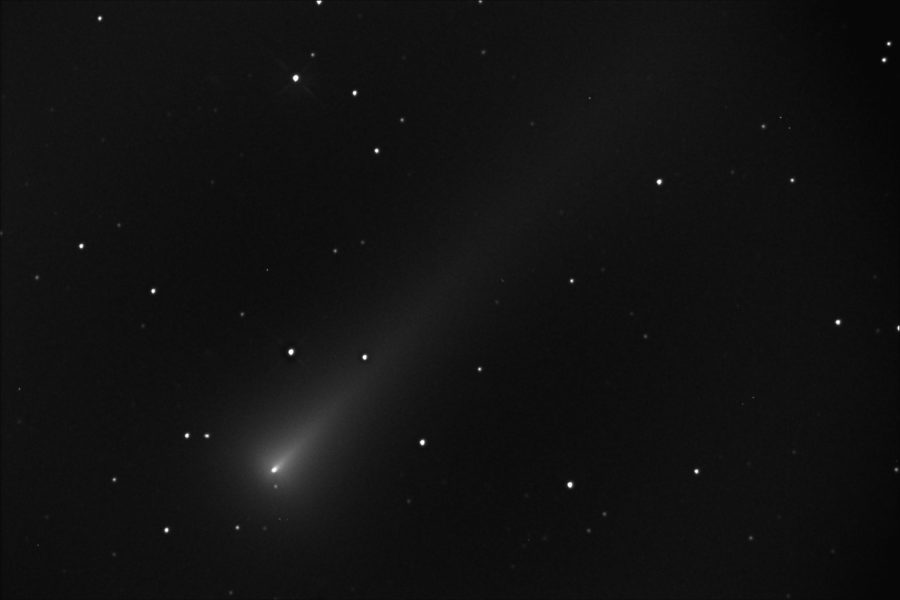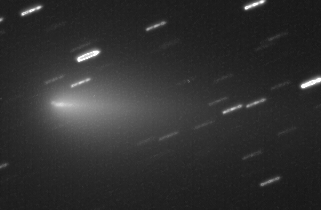I was able to shoot a 20 second image using the Tombaugh Reflector of Comet 2021 A1. It was just before 5:00 AM local time (11:00 UTC) and the comet was about 30 degrees above the horizon. The winds were about 6-8 MPH so not great for keeping the imaging steady. (hopefully we’ll fix that sensitivity to wind with a telescope makeover later this winter/early spring. ) There is some doubt the comet will survive the trip around the sun. If the nucleus breaks up too early there may not be much left to see. On the other hand if it breaks up just before the time for our best view it could become spectacular like C/2019 Y4 did a couple of years ago. Stay tuned.
Perseid Meteor captured
A Perseid meteor was captured using a StarShoot Pro v2 camera mounted on a StarSync Tracker at Sandlot Observatory. The meteor showed up on an image taken 08-11-21 at 11:32 PM CDST. The FOV was 26.4 x 17.6 degrees and the image was 4 minutes long. Like a lot of Perseid shower members it followed down the summer Milky Way. Notice the asterism the ‘coathanger’ just below center in the image.
Gary

178P Comet (Hug-Bell) has developed a longer tail.
Here’s a picture of 178P taken with the .56 meter reflector at Sandlot Observatory. Its a stack of 16 – 1 minute images taken the early morning of 10-5-20. Each image was moved the distance and direction as the comet in its motion against the star background.
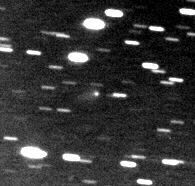
The comet has sprouted a wide tail about 25 arc-seconds long extending away from the coma. The tails angle is about 260 P. A. or just a bit south of due west. The comet is at 17.7 V magnitude but isn’t going to get much brighter over the next few weeks, topping out about 17.5 V. Its currently up 60 degrees by the beginning of dawn.
Comet 178P Returns
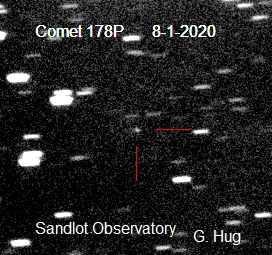
The comet discovered by Graham Bell and I (C/1999 X1) at Farpoint in December 1999 and was subsequently number 178P by the Minor Planet Center has been recovered for the third time. Each orbit takes 7 years to go around the sun. This recovery image Is a stack of 20 – 30 second images taken at Sandlot Observatory the morning of 8-1-2020.
Comet C/2019 Y4 disintegration

disintegrating comet C/2019 Y4
Comet C/2019 Y4 held promise to be a spectacular comet, possibly visible to the naked eye in May 2020. Unfortunately as a lot of comets passing close to the sun, Comet C/2019 Y4 is beginning to disintegrate. This image of the comet was taken the evening of April 9th, (April 10 U.T.) with the Little Blue 22″ at Sandlot Observatory.
You can see the small star-like piece that has broken away from the main nucleus. It is located just left and above the rest of the nuclear region. Once the flurry of activity subsides the comet will not likely become any brighter an average passing comet of roughly 9th to 10th magnitude.
Image Details;
22″ f4.1 reflector imaging at prime focus with a ST10XME CCD Camera. The image was comprised of a stack of 24 – 30 second images . Each image was offset in the direction of the comet’s motion via Astrometrica. The image above was cropped out of the original 22 x 14 arc-minute field of view.
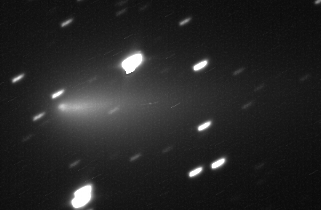
C/2019 Y4 Image taken Apr 15 – changing fragmentation . There are now several components to the nucleus. One bright fragment in the left and a smaller fragment just below the bright one (barley discernible in the image) and a fainter condensation further toward the tail.
Interstellar Comet?
There is a comet-looking object on the NEOCP that is likely the next interstellar to enter our solar system. The object is temporarily designated as gb00234. It was discovered by L51 Margo observatory a couple of nights ago. Here is a rather
poor image taken just as dawn was breaking on 09-11-19.
The image is a composite of 3 – 1 minute images taken with an ST10 XME camera mounted on the 0.57meter Little Blue Reflector. It will be interesting to see what media does with this.
Gary Hug
M87’s black hole
Here’s M87 taken with my 22″ Reflector and an ST-8 CCD camera. The image show the jet of material traveling at some percentage of the speed of light while being squeezed out before reaching the event horizon . This does correlate with the black hole at M87 center that was recently ‘imaged’ and publicized. The ST-8 image taken at Sandlot Observatory was imaged on 04-02-19.
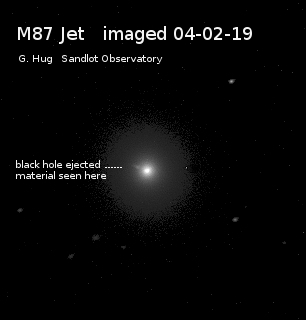
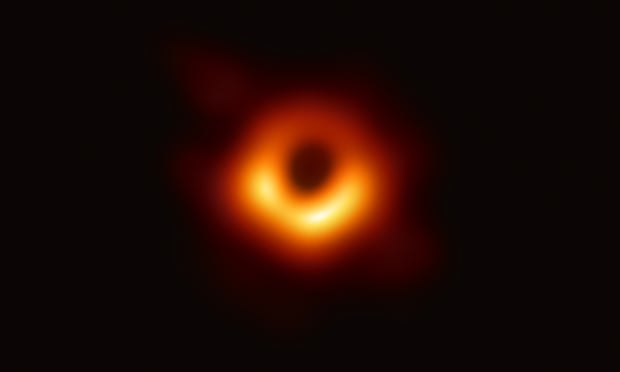
This image by the Event Horizon Telescope project shows the event horizon of the supermassive black hole at the heart of the M87 galaxy. Credit: EHT Collaboration
Asteroid 6478 Gault sprouted a tail.
A long known asteroid suddenly sprouted a long narrow tail. This is a 22 minute (45 secs x 30) cropped imaged taken with the Tombaugh Reflector at Farpoint 01-10-19 about 8:00 U.T. The tail was visible faintly in each of the 45 second images. This asteroid may have developed the tail through an impact with another rock. [T08] ATLAS Mauna Loa images 1-5.5 U.T. showed a comet like tail extending from the asteroid and comments started flowing on mpml and comet ml list servers. A couple of months ago it went through a 2 magnitude outburst and is still at that level as of last night. 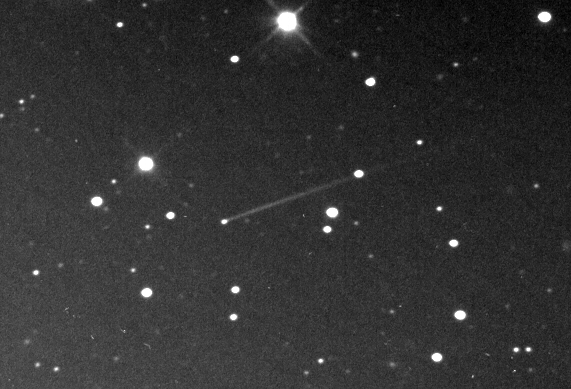
NEO Follow-up Targets
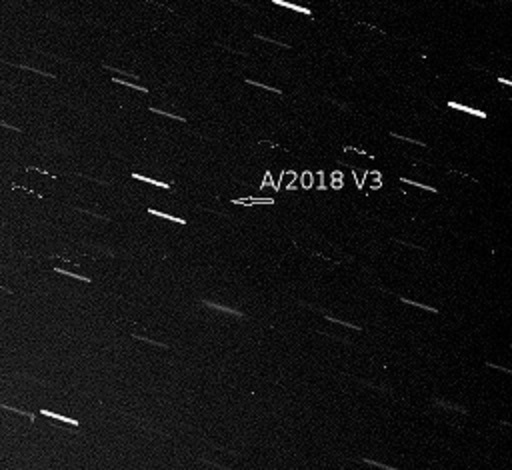 I originally thought A/2018 V3 was an asteroid (although it may end up being a comet) with a very long perihelion distance. But I was wrong; its max distance is just 4 A.U.’s but the eccentricity is .989( 99 times longer than wide orbit) and its inclination to the solar system is 165 degrees (almost perpendicular.)
I originally thought A/2018 V3 was an asteroid (although it may end up being a comet) with a very long perihelion distance. But I was wrong; its max distance is just 4 A.U.’s but the eccentricity is .989( 99 times longer than wide orbit) and its inclination to the solar system is 165 degrees (almost perpendicular.)
Anyway some of the objects in our NEO follow-up program are as faint or even a bit dimmer than 21.5 V magnitude. Even with the arrow pointing to the object its hard to see. Only with consistent movement in the predicted angle is it identifiable as a target. This image is a combination of 14 – 2minute images taken on the night of 11-14-18 and severely cropped. At the time the MPC listed it as 21.6 V magnitude. It would also be easier to see inverted (dark stars on white background) .
Gary
Comet 21P Giacobini-Zinner returns
This 5 minute image of the returning comet 21P (Giacobini-Zinner) was taken Sept 16, 2018 using a Cannon EOS coupled to an Apogee 80mm F6.25 refractor. The mount was a SST EQ-25 HPFD . At the time of this image, the comet was in the middle of the constellation Auriga.

